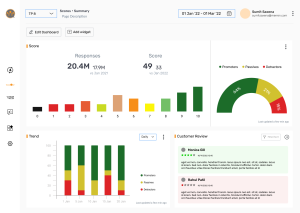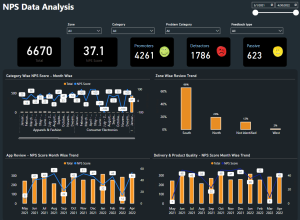Monitoring and improving customer satisfaction can seem like a daunting task. However, with the right tools and strategies, it becomes much more manageable. One such tool is the Customer Satisfaction (CSAT) dashboard.
Let us explore the use of customer satisfaction surveys
What Is A Customer Satisfaction Survey?
There are three metrics that are the gold standard to assess customer satisfaction, identify detractors and improve customer experience. There are three major types of satisfaction surveys.
- The net promoter score (NPS)
- Customer satisfaction score (CSAT)
- Customer effort score (CES)
A customer satisfaction (CSAT) survey is one of the market standard metrics used to measure the satisfaction levels of a customer. These metrics often consist of a single question followed by an open-ended question.
Create a customer satisfaction survey with Merren CX
Sign up for a 14 day free trial with Merren CX without any credit card details. The Merren dashboard will have all the necessary tools needed to create, preview and launch your first survey.
- Go to +create a survey section. You can create a survey from scratch or create your first CSAT survey with pre-designed templates.
- Fill out the survey details and choose customer satisfaction from the drop down options. Go to the ‘question tab’.
- Click on ‘add new element’ and choose ‘add a new section.’ Here you can choose from NPS, CES or a CSAT score survey.
- You can run customer satisfaction surveys via various survey channels. Opt for WhatsApp surveys, Messenger surveys, dynamic emails or chatbots for a high response rate.

Why is a customer satisfaction survey important?
- Get Direct Insights: Hear straight from customers about their experiences.
- See How You’re Doing: Evaluate how well you’re meeting customer needs.
- Find Strengths and Weaknesses: Discover what you’re great at and what needs work.
- Keep Customers Coming Back: Happy customers are loyal customers.
- Make Things Better: Use feedback to improve products and services.
- Stand Out from the Crowd: Be known for exceptional customer experiences.
- Protect Your Reputation: Build on positives, learn from negatives.
- Plan for the Future: Use insights to shape your business strategy.
- Keep Employees Engaged: Get your team focused on customer satisfaction.
- Make Informed Choices: Use data to drive decision-making.
What is a Customer Satisfaction (CSAT) Dashboard?
A CSAT dashboard is a visual reporting tool that tracks customer satisfaction survey results in real time. Instead of digging through raw survey responses, a dashboard helps you monitor trends, identify pain points, and take quick action to improve customer experience. For organisation, an AI-powered CSAT dashboard helps bring clarity to decision-making.
Why do you need a CSAT dashboard?
- Real-time visibility – Spot customer pain points instantly.
- Centralized insights – Compare CSAT with NPS, CES, and other KPIs.
- Actionable tracking – Prioritize improvements where they matter most.
- Team alignment – Give marketing, support, and product teams one single source of truth.
Example: An eCommerce brand noticed low CSAT scores after checkout. The dashboard helped identify that delivery delays were the root cause. Fixing logistics raised CSAT by 22% in just 2 months.
Components of a Customer Satisfaction (CSAT) Dashboard?
A CSAT dashboard has components that combine key performance indicators (KPIs), operational metrics, and focus areas that highlight what’s driving or dragging down customer satisfaction.
Key performance indicators (KPIs)
Key performance indicators (KPIs) help measure customer satisfaction. These include metrics such as net promoter score (NPS), customer effort score (CES), and response time. Here are the most common KPIs and why they matter:
- Net Promoter Score (NPS): CSAT measures satisfaction with a specific interaction, while NPS looks at overall loyalty. By asking customers how likely they are to recommend your brand, you get a sense of advocacy and long-term engagement. A CSAT dashboard that includes NPS alongside satisfaction scores provides a complete picture of short-term happiness and long-term loyalty.
- Customer Effort Score (CES): This measures how easy it is for customers to interact with your company. For example, if a customer had to contact support multiple times for a simple query, their CES score would drop even if they eventually resolved the issue. A CSAT dashboard that tracks CES highlights friction points in the journey, helping teams remove unnecessary hurdles.
- Response Time: Speed matters in customer service. A slow response can hamper the online reputation of a brand. Measuring average response time in the dashboard shows how quickly support teams acknowledge and resolve issues. Faster response times often correlate directly with higher CSAT scores.
- Sentiment Analysis (AI-driven): Beyond numbers, customer comments reveal emotions. With an AI-powered dashboard analysis, a CSAT dashboard can categorize open-text feedback as positive, negative, or neutral. This helps spot patterns (example: repeated frustration with billing or delight with a new feature) that numerical scores alone cannot explain.
Operational metrics to focus on
Beyond core KPIs, businesses should track operational metrics that show how processes, teams, and systems impact satisfaction:
- Support Team Performance: A CSAT dashboard can break down satisfaction by agent or team. This helps identify top performers, areas where training is needed, and overall service consistency.
- Customer Journey Segments: Satisfaction often varies at different stages such as onboarding, purchase, delivery, or support. Dashboards that allow segmentation reveal where satisfaction is dropping, whether it’s checkout friction, shipping delays, or post-purchase engagement.
- Resolution Quality: Closing a ticket fast doesn’t always mean the problem was solved well. Resolution quality metrics ensure teams are not only quick but also effective in addressing customer needs.
Categories of customer feedback
Raw survey data becomes actionable when organized into meaningful categories. A good CSAT dashboard doesn’t just display scores—it classifies feedback into themes such as:
- Product-related feedback – Ease of use, security issues of a digital product, reliability, or missing features.
- Service-related feedback – Friendliness, professionalism, and expertise of support staff in the customer journey.
- Process-related feedback – Billing, post-purchase customer support, product delivery, or account setup.
What the dashboard will generally do: It will group feedback based on recurring feedback and assign as per urgency. Example: repeated complaints about “delivery delays” should trigger improvements in logistics, while “confusing billing” points to finance or IT teams.
How to Use a CSAT Dashboard Effectively?
A CSAT dashboard provides crucial insights but it is important to know how to interpret the data and take action based on the feedback received.
Identifying detractors and study market trends:
One of the key benefits of a CSAT dashboard is the ability to identify latest market trends and patterns. Pin point on recurring issues, common pain points, and satisfaction patterns. This insight helps businesses proactively reach out to every unhappy customer and close feedback loop. Implement measures to enhance brand loyalty using data-driven decisions. A CSAT dashboard aids in identifying app performance issues, frequently asked queries, or improving specific processes.
Act on customer feedback and offer fast resolution:
The CSAT dashboard empowers businesses to act on customer feedback promptly. This proactive approach is useful when resolving individual customer issues. Support teams can identify systemic problems and share data with CX professionals.

Supercharge Customer Experience Process with the CSAT Dashboard
Here are the 3 ways of improving customer retention using data from a CSAT dashboard.
Celebrate CS agents’ achievements and offer apt rewards:
Recognize and reward customer support team members who consistently deliver high levels of customer satisfaction. Celebrating these achievements not only boosts team morale but also fosters a culture of excellence. Larger companies such as Apple also focus on employee management metrics. This in turn brings greater brand loyalty among Apple users. Managers can also use the data from the dashboard to identify top-performers and provide ongoing training and development opportunities.
Pin-point areas that need constant improvement:
A CSAT dashboard guides businesses in making informed decisions and implementing changes to enhance CX. This includes improving the cookie policy on your website, streamlining support processes, or optimising response times. Continuously monitor dashboard insights, meet competitive advantage, deliver memorable CX and stay on top of the minds of your consumers.
Get real-time data and meet customer expectations:
A well-utilized CSAT dashboard enables businesses to meet customer expectations effectively. This includes tracking customer needs, satisfaction ratings, and pain points. Leveraging this insight, organisations can tailor their products/services, and support to align with customer expectations. A real time dashboard data can help teams and stakeholders effectively. This leads onto important product and service upgrade discussions. This includes improved product features, extended free trial periods, or conducting short surveys to gather customer feedback.

How Can Merren’s CSAT Dashboard Transform Your Business?
Merren’s AI-powered CSAT dashboard will optimize internal processes and workflows. Here are some ways how any business across industries will benefit:
- Enhancing customer satisfaction: By actively tracking and acting on customer feedback, businesses can continuously improve the CX, boost satisfaction levels, and create loyal customer advocates.
- Improving customer retention: This dashboard helps businesses understand customer pain points, satisfaction trends, and identify areas to focus on to improve customer retention rates.
- Making data-driven decisions: Get access to real-time, accurate data that aids in making informed decisions to enhance customer satisfaction, retention, and overall business performance.
- Handle customer queries better: This enables teams to extract data faster, handle queries and complaints efficiently, and reallocate resources as per internal requirements.
Conclusion
A customer satisfaction dashboard will track real time data, check for unresolved tickets, reach out to your team and make necessary actions. Let your actions be backed by data, realistic insights, touchpoint metrics, and satisfaction scores.The customer satisfaction dashboard includes a variety of charts with graphical views of your system’s customer satisfaction data. Measure, monitor, manage and visualize customer data all in one CSAT dashboard. Create hands free surveys using Merren’s pre-designed survey templates and launch them at various touch-points.

